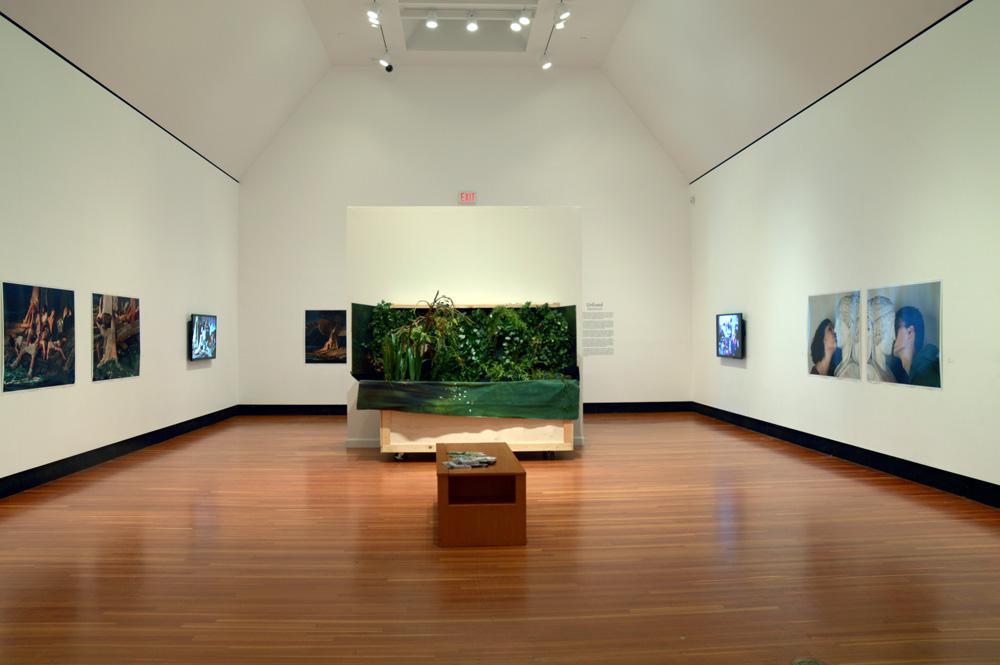A startling Ophelia figure confronted the viewer upon entering Adad Hannah’s recent exhibition “Unfixed” at Two Rivers Gallery in Prince George. She lay serene in a sheer, floating dress, with a clear, white face and a flow of red hair; she was shrouded by abundant blades of grass, bright flowers, and a sawed-off log. But then, her still, picture-perfect face moved; Ophelia blinked her eyes, and her throat rose hesitantly, then fell. A slight shiver tremored her hands, which were spread out in surrender to dark forces below.
This scene—displayed on a high-definition monitor as part of Hannah’s piece Blackwater Ophelia (2013)—was hard to watch, with the weight of the heroine’s story drawing us into heartbreak, despair and the waste of beauty giving in so wholeheartedly. This sense of high emotion held even as the viewer passed the false wall upon which the monitor was mounted, and saw the casket-like set in which Hannah filmed the piece. It has elements clearly designed for supporting the model’s head and feet, and the flowers are plastic—but even seeing this artifice didn’t dispel the power of Hannah’s tableau vivant. It really did seem that Ophelia came to life and arrived on the brink of death, right before our eyes.
Hannah’s work mesmerizes; the shock of seemingly still artworks that are created with breathing, wavering, crying actors startles the viewer into a shared experience. His work transports the viewer from the slow silence of a museum, circling Rodin’s The Burghers of Calais (1889), to the noisy streets of Seoul, where he circles his re-creation Burghers of Seoul (2006)—South Korean motorcycle messengers in poses of despair, consternation and pride taken from Rodin’s masterwork. Hannah’s art, playing with perceptions via skilled sleight of hand, reveals itself but never lose its power; instead, fascination builds with each work. Viewers delve into the performances, judging the actors; some limbs falter and flail, others hardly move.
Hannah’s image of two figures—one taller than the other as if mother and child—sharing a black shroud and viewing Bosch’s The Garden of Earthly Delights (c. 1500) haunts me still. At first, I read the figures as nuns; then curiosity turned to discomfort the longer I looked—or watched—as they became increasingly sinister. I was convinced they were ghouls until I thought that I saw their faint faces in an adjacent work, Room 112 (2004). There, I saw them as figures peering in at another painting, bringing me back to the work and out of my own imaginings.
Virginia Hall, 1914 (2014) is a new work that employs Hannah’s signature tableau vivant style using Prince George citizens as actors. (BC residents also came to the fore in his 2009 work The Raft of the Medusa (100 Mile House).) Opened on January 16, 1914, as part of Prince George’s Fort George Hotel, Virginia Hall was a rollicking dance venue and a centre of the growing city’s social life until it, and the hotel, burned down a few months into existence.
Hannah’s Virginia Hall, 1914 is an homage and memorial to the old dance hall’s place and time; a series of scenes portray a thin veneer of civility in the pleasing, sometimes distant, and sad smiles of its women, as well as in the eager, lascivious, showing-off grins of its men. In the background of one scene is a woman with a dagger in her hand, moving towards the back of a laughing man. Another woman holds deer antlers to her head; bear, wolverine and fox skins are draped on heads of frightened women, as if they are being devoured. Such vignettes foreshadow the start of the First World War, as well as the demise of the hotel and the gaiety it provided.
In this and other works, “Unfixed” unsettled the viewer, true to its word.









